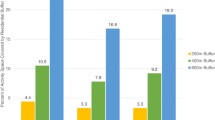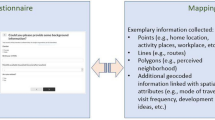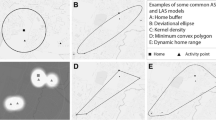Abstract
The aim of this study was to examine the spatial mobility of homeless people in urban areas, exploring homeless mobility, its drivers, limits and links to personal attributes, and whether there is an association between the extent of spatial activity and an individual’s housing situation. To our knowledge, there has been no prior exhaustive attempt to explore the spatial mobility of homeless people using Global Positioning System (GPS) location devices. The theoretical background of the research was based on time-geography approaches. The research used a mixed method approach involving participatory GPS mapping. Spatial mobility was measured by GPS location devices. GPS tracking made it possible to capture the precise location of a person in time and space, and subsequently to identify the daily and weekly mobility rhythms of such people. The GPS data were further contextualised by conducting interviews with homeless people and asking about their daily mobility. The groundwork for the interviews resulted in printed maps of the participants’ daily spatial mobility (n = 598). The combination of time-location data and ethnographic methods presented several technical and organisational difficulties, but the pilot study provided valuable knowledge about the everyday-life mobility of homeless people in cities. A novel understanding of the links between homeless mobilities, urban commons and the life conditions of homeless people can inform current welfare policies relating to the poor.

Note: Rare cases of mobility beyond 60 kilometres are excluded from the figures in order to improve visual readability


Similar content being viewed by others
Notes
Obviously, this numerical data is also socially constructed and its seeming objectivity is therefore only relative. To highlight this issue, we placed the word ‘objective’ in quotation marks.
The map interviews will be analysed in detail in a separate article, that will complement this one.
References
Agans, R. P., Jefferson, M. T., Bowling, J. M., Zeng, D., Yang, J., & Silverbush, M. (2014). Enumerating the hidden homeless: strategies to estimate the homeless gone missing from a point-in-time count. Journal of Official Statistics, 30(2), 215–229.
Amore, K., Baker, M., & Howden-Chapman, P. (2011). The ETHOS definition and classification of homelessness: An analysis. European Journal of Homelessness, 5(2), 19–37.
Anderson, N. (1923). The hobo: The sociology of the homeless man. Chicago: University of Chicago Press.
Beijer, U., Wolf, A., & Fazel, S. (2012). Prevalence of tuberculosis, hepatitis C virus, and HIV in homeless people: a systematic review and meta-analysis. The Lancet Infectious Diseases, 12(11), 859–870.
Bretherton, J. (2017). Homelessness and gender reconsidered. European Journal of Homelessness, 11(1), 1–22.
Bourlessas, P. (2018). ‘These people should not rest’: mobilities and frictions of the homeless geographies in Athens city centre. Mobilities, 13(5), 746–760.
Bukowski, K., & Buetow, S. (2011). Making the invisible visible: a Photovoice exploration of homeless women’s health and lives in central Auckland. Social Science and Medicine, 72(5), 739–746.
Busch-Geertsema, V. (2015). Discussion paper on HABITACT peer review on homelessness policies in Odense City (Denmark). Odense City.
Casey, R., Goudie, R., & Reeve, K. (2008). Homeless women in public spaces: strategies of resistance. Housing Studies, 23(6), 899–916.
Chaix, B., Meline, J., Duncan, S., Merrien, C., Karusisi, N., Perchoux, C., et al. (2013). GPS tracking in neighborhood and health studies: a step forward for environmental exposure assessment, a step backward for causal inference? Health & Place, 21, 46–51.
COST Action 15218. (2016). Memorandum of Understanding for the implementation of COST Action “Measuring homelessness in Europe” (MEHO) CA 15218. Brussel: COST Association.
Cook, N., & Butz, D. (Eds.). (2018). Mobilities, mobility justice and social justice. Routledge.
Cresswell, T. (2012). Mobilities II: still. Progress in Human Geography, 36(5), 645–653.
DeVerteuil, G. (2003). Homeless mobility, institutional settings, and the new poverty management. Environment and Planning A, 35(2), 361–379.
DeVerteuil, G., May, J., & Von Mahs, J. (2009). Complexity not collapse: recasting the geographies of homelessness in a ‘punitive’ age. Progress in Human Geography, 33(5), 646–666.
Duncan, D. T., Kapadia, F., Regan, S. D., Goedel, W. C., Levy, M. D., Barton, S. C., et al. (2016). Feasibility and acceptability of global positioning system (GPS) methods to study the spatial contexts of substance use and sexual risk behaviors among young men who have sex with men in New York City: a p18 cohort sub-study. PLoS ONE, 11(2), e0147520.
Ellegård, K. (2018). Thinking time geography: Concepts, methods and applications. Abingdon: Routledge.
Ensign, J. (2003). Ethical issues in qualitative health research with homeless youths. Journal of Advanced Nursing, 43(1), 43–50.
Etický kodex české asociace pro sociální antropologii (The Ethical Code of the Czech Association for Social Anthropology). (2019). http://www.casaonline.cz/?page_id=7. Accessed May 10, 2017.
Farrugia, D., & Gerrard, J. (2016). Academic knowledge and contemporary poverty: the politics of homelessness research. Sociology, 50(2), 267–284.
Freudendal-Pedersen, M. (2015). Whose commons are mobilities spaces? The Case of Copenhagen’s cyclists. ACME: An International Journal for Critical Geographies, 14(2), 598–621.
Hägerstrand, T. (1970). What about people in regional science? Papers of the Regional Science Association, 24(1), 7–21.
Hägerstrand, T. (1982). Diorama, path and project. Tijdschrift voor economische en sociale geografie, 73(6), 323–339.
Hall, T., & Smith, R. J. (2013). Stop and go: a field study of pedestrian practice, immobility and urban outreach work. Mobilities, 8(2), 272–292.
Hartter, J., Ryan, S. J., MacKenzie, C. A., Parker, J. N., & Strasser, C. A. (2013). Spatially explicit data: stewardship and ethical challenges in science. PLoS Biology, 11(9), e1001634.
Helbich, M. (2018). Toward dynamic urban environmental exposure assessments in mental health research. Environmental Research, 161(2), 129–135.
Hirsch, J. A., Winters, M., Clarke, P., & McKay, H. (2014). Generating GPS activity spaces that shed light upon the mobility habits of older adults: A descriptive analysis. International Journal of Health Geographies, 13(1), 51.
Hodgetts, D., & Stolte, O. (2016). Homeless people’s leisure practices within and beyond urban socio-scapes. Urban Studies, 53(5), 899–914.
Hoolachan, J. E. (2016). Ethnography and homelessness research. International Journal of Housing Policy, 16(1), 31–49.
Huey, L., & Berndt, E. (2008). ‘You’ve gotta learn how to play the game’: Homeless women’s use of gender performance as a tool for preventing victimization. The Sociological Review, 56(2), 177–194.
Jackson, E. (2012). Fixed in mobility: Young homeless people and the City. International Journal of Urban and Regional Research, 6(4), 725–741.
Jocoy, C. L., & Del Casino Jr, V. J. (2010). Homelessness, travel behavior, and the politics of transportation mobilities in Long Beach, California. Environment and Planning A, 42(8), 1943–1963.
Johnsen, S., & Fitzpatrick, S. (2010). Revanchist sanitisation or coercive care? The use of enforcement to combat begging, street drinking and rough sleeping in England. Urban Studies, 47(8), 1703–1723.
Kawash, S. (1998). The homeless body. Public Culture, 10(2), 319–339.
Kwan, M. P., Wang, J., Tyburski, M., Epstein, D. H., Kowalczyk, W. J., & Preston, K. L. (2018). Uncertainties in the geographic context of health behaviors: A study of substance users’ exposure to psychosocial stress using GPS data. International Journal of Geographical Information Science, 33(6), 1–20.
MacLeod, G. (2002). From urban entrepreneurialism to a “revanchist city”? On the spatial injustices of Glasgow’s renaissance. Antipode, 34(3), 602–624.
Marquardt, N. (2016). Counting the countless: Statistics on homelessness and the spatial ontology of political numbers. Environment and Planning D: Society and Space, 34(2), 301–318.
Martinez, A. N., Lorvick, J., & Kral, A. H. (2014). Activity spaces among injection drug users in San Francisco. International Journal of Drug Policy, 25(3), 516–524.
May, J. (2000). Of nomads and vagrants: Single homelessness and narratives of home as place. Environment and Planning D: Society and Space, 18(6), 737–759.
Miller, H. J. (2005). A measurement theory for time geography. Geographical analysis, 37(1), 17–45.
Minnery, J., & Greenhalgh, E. (2007). Approaches to homelessness policy in Europe, the United States, and Australia. Journal of Social Issues, 63(3), 641–655.
Mitchell, D. (2003). The right to the city: Social justice and the fight for public space. New York: Guilford Press.
Mostowska, M. (2019). Metaphors and evidence. Producing numbers in national homelessness counts. Housing, Theory and Society. https://doi.org/10.1080/14036096.2019.1600015.
Murphy, E. R. (2019). Transportation and homelessness: A systematic review. Journal of Social Distress and the Homeless. https://doi.org/10.1080/10530789.2019.1582202.
Nikolaeva, A., Adey, P., Cresswell, T., Lee, J. Y., Nóvoa, A., & Temenos, C. (2019). Commoning mobility: Towards a new politics of mobility transitions. Transactions of the Institute of British Geographers. https://doi.org/10.1111/tran.12287.
Noack, R. (2018). Hungary bans homeless people from living in public spaces, in law described as ‘cruel’ by the U.N. https://www.washingtonpost.com/world/2018/10/17/hungary-bans-homeless-people-living-public-spaces-law-described-cruel-by-un. Accessed November 20, 2018.
North, C. S., Wohlford, S. E., Dean, D. J., Black, M., Balfour, M. E., Petrovich, J. C., et al. (2017). A pilot study using mixed GPS/narrative interview methods to understand geospatial behavior in homeless populations. Community Mental Health Journal, 53(6), 661–671.
O’Sullivan, E. (2012). Varieties of punitiveness in Europe: Homelessness and Urban marginality. European Journal of Homelessness, 6(2), 69–97.
O’Sullivan, F. (2014). A Danish City is using GPS to track (and help) the homeless. www.citylab.com/solutions/2014/09/a-danish-city-is-using-gps-to-track-and-help-the-homeless/380516/. Accessed April 25, 2016.
Propen, A. D. (2005). Critical GPS: Toward a new politics of location. ACME: An International Journal for Critical Geographies, 4(1), 131–144.
Rainham, D., McDowell, I., Krewski, D., & Sawada, M. (2010). Conceptualizing the healthscape: contributions of time geography, location technologies and spatial ecology to place and health research. Social Science and Medicine, 70(5), 668–676.
Reitzes, D. C., Parker, J., Crimmins, T., & Ruel, E. E. (2016). Digital communications among homeless people: Anomaly or necessity? Journal of Urban Affairs. https://doi.org/10.1111/juaf.12310.
Robinson, T. (2017). No right to rest: police enforcement patterns and quality of life consequences of the criminalization of homelessness. Urban Affairs Review, 55(1), 41–73.
Rollinson, P. A. (1998). The everyday geography of the homeless in Kansas City. Geografiska Annaler: Series B, Human Geography, 80(2), 101–115.
Rossi, P. H. (1989). Down and out in America. The origins of homelessness. Chicago: The University of Chicago Press.
Sano, A., Taylor, S., McHill, A. W., Phillips, A. J., Barger, L. K., Klerman, E., et al. (2018). Identifying objective physiological markers and modifiable behaviors for self-reported stress and mental health status using wearable sensors and mobile phones: Observational study. Journal of Medical Internet Research, 20(6), e210.
Sheller, M., & Urry, J. (2006). The new mobilities paradigm. Environment and Planning A, 38(2), 207–226.
Shoval, N. (2008). Tracking technologies and urban analysis. Cities, 25(1), 21–28.
Shoval, N., & Ahas, R. (2016). The use of tracking technologies in tourism research: the first decade. Tourism Geographies, 18(5), 587–606.
Šimon, M., Vašát, P., Poláková, M., Gibas, P., & Daňková, H. (2019). Activity spaces of homeless men and women measured by GPS tracking data: A comparative analysis of Prague and Pilsen. Cities, 86, 145–153.
Small, M. L. (2018). Rhetoric and evidence in a polarized society. Available at https://www.russellsage.org/sites/default/files/MLSmall_Qualitative2018.pdf. Accessed 15 Apr 2019.
Smith, N. (1996). The new urban frontier: Gentrification and the Revanchist City. Abingdon: Psychology Press.
Šnajdrová, Z., & Holpuch, P. (2010). Sčítání bezdomovců na území hlavního města Prahy. Závěrečná zpráva (The homelessness monitor in the area of the capitol city of Prague. Final report). Prague: Prague City Hall.
Spradley, J. (1970). You owe yourself a drunk: Adaptive strategies of urban nomads. Boston: Little Brown.
Takahashi, L. M. (1996). A decade of understanding homelessness in the USA: from characterization to representation. Progress in Human Geography, 20(3), 291–310.
Taylor, L. (2016). No place to hide? The ethics and analytics of tracking mobility using mobile phone data. Environment and Planning D: Society and Space, 34(2), 319–336.
Temelová, J., Jíchová, J., Pospíšilová, L., & Dvořáková, N. (2017). Urban social problems and marginalized populations in postsocialist transition societies: Perceptions of the City Center of Prague, the Czechia. Urban Affairs Review, 53(2), 273–304.
Udvarhelyi, E.T. (2014). If we don’t push homeless people out, we will end up being pushed out by them: The criminalization of homelessness as state strategy in Hungary. Antipode, 46(3), 816–834.
Váně, J., & Kalvas, F. (2014). Fenomén bezdomovectví. Výzkumná zpráva (The homelessness phenomenon. Research report). Pilsen: University of West Bohemia. Retrieved January 3, 2017 http://socialnisluzby.plzen.eu/Files/soc/dokumenty/bezdomovectvi_zkracena_verze.pdf.
Vyhodnocení průzkumu řešení bezdomovectví v obcích s rozšířenou působností. (2015). Prague: Ministry of Labour and Social Affairs.
Wolch, J. R., Rahimian, A., & Koegel, P. (1993). Daily and periodic mobility patterns of the urban homeless. The Professional Geographer, 45(2), 159–169.
Wolch, J. R., & Rowe, S. (1992). On the streets: mobility paths of the urban homeless. City & Society, 6(2), 115–140.
Wright, T. (1997). Out of place. Homeless mobilizations, subcities, and contested landscapes. New York: State University of New York.
Zajonc, R. B. (1968). Attitudinal effects of mere exposure. Journal of Personality and Social Psychology, 9(2p2), 1.
Zlotnick, C., Zerger, S., & Wolfe, P. B. (2013). Health care for the homeless: What we have learned in the past 30 years and what’s next. American Journal of Public Health, 103(S2), S199–S205.
Acknowledgements
The article is output of the research project Time and Space of Homeless Persons in a Post-socialistic City: A Comparison of Prague and Pilsen, funded by the Czech Science Foundation.
Funding
This work was supported by The Czech Science Foundation (Grant Number GA15-17540S).
Author information
Authors and Affiliations
Corresponding author
Ethics declarations
Conflict of interest
The authors declare that they have no conflict of interest.
Research involving human participants and/or animals
All participants were informed about the research plan and all signed an informed consent form enabling their research participation.
Additional information
Publisher's Note
Springer Nature remains neutral with regard to jurisdictional claims in published maps and institutional affiliations.
Rights and permissions
About this article
Cite this article
Šimon, M., Vašát, P., Daňková, H. et al. Mobilities and commons unseen: spatial mobility in homeless people explored through the analysis of GPS tracking data. GeoJournal 85, 1411–1427 (2020). https://doi.org/10.1007/s10708-019-10030-4
Published:
Issue Date:
DOI: https://doi.org/10.1007/s10708-019-10030-4




